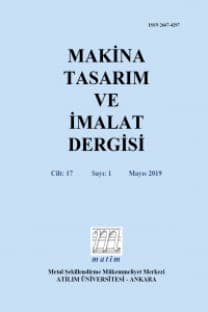AISI 316L Paslanmaz Çeliğin Diş Tornalama İşlemi Sırasında Farklı Kesme Stratejilerinin ve Parametrelerinin Yüzey Kalitesi ve Kesici Takım Aşınması Üzerindeki Etkilerinin Optimizasyonu ve Araştırılması
Diş çekme, Kesme Stratejileri, Takım aşınması, Optimizasyon
Influences of Cutting Strategies and Parameters on Tool Wear in Threading Operation of 316L Stainless Steel
Threading, cutting strategies, Tool wear, Optimization,
___
- M. Yasir, T. L. Ginta, B. Ariwahjoedi, A. U. Alkali, M. Danish, Effect of cutting speed and feed rate on surface roughness of AISI 316l ss using end-milling, ARPN Journal of Engineering and Applied Sciences, Vol. 11, No. 4, 2016
- Ezugwu, E.O.; Okeke, C.I.; Machado A.R. (1998) High speed threading of inclusion-modified steels with coated carbide tools. Journal of Materials Processing Technology, 86: 216–222.
- B. Siqueira, S.A. Freitas, R. B. D. Pereira, C. H. Lauro, L. C. Brandão, Influence of chip breaker and helix angle on cutting efforts in the internal threading process, The International Journal of Advanced Manufacturing Technology, 2019
- R. C. E. Júnior, R. B. D. Pereira, C. H. Lauro, L. C. Brandão, Research on the wear mechanisms during the high-speed tapping in 316L stainless steel, The International Journal of Advanced Manufacturing Technology, 2020
- Ondin O, Kıvak T, Sarıkaya M, Yıldırım V (2020) Investigation of the influence of MWCNTs mixed nanofluid on the machinability characteristics of PH 13-8 Mo stainless steel. Tribol Int 148:106323
- I. C. Pereira, M. B. da Silva, Study of the internal thread process with cut and form taps according to secondary characteristics of the process, Int J Adv Manuf Technol, 2017
- H. K. Akyildiz, H. Livatyali, Prediction and experimental analysis of cutting forces during machining of precision external threads, Machining Science and Technology, 2011, 15:485–506
- Astakho, V.P. (2004) The assessment of plastic deformatio in metal cutting. Journal of Materials Processing Technology, 146: 193–202.7. H. Kato, S. Nakata, N. Ikenaga, H. Improvement of chip evacuation in drilling of lead-free brass using micro drill, International journal of automation technology, 8; 2014.
- https://www.viraj.com/admin/sites/default/files/Viraj-Profiles-Catalogue_0.pdf
- Espritcam 2017 commerical software help/DP Technology
- http://www.helmancnc.com/fanuc-31i-g-codes-machining-center-fanuc-30i-31i-32i/
- https://www.mmsonline.com/articles/threading-on-a-lathe
- L. V. Candioti, M. M. De Zan, M. S. Cámara, H. C. Goicoechea, Experimental design and multiple response optimization. Using the desirability function in analytical methods development, Talanta, Volume 124, 15 June 2014, Pages 123-138
- ISSN: 1302-9487
- Başlangıç: 1986
- Yayıncı: Makina Tasarım ve İmalat Derneği
Az Alaşımlı Çelikten Üretilen Yatak Başlığının Kum Kalıba Döküm Optimizasyonu
Yücel AYDOĞAN, Özlem KARATAŞ ERTAN
Çok Fonksiyonlu Paralel Geçit ve Yüzme Merdiveni Tasarımı ve Analizi
Nima ZOGHİPOUR, Akif YARATAN, Ferhat ÇELİK, Yusuf KAYNAK
Havada Görevlendirilebilen Tekerleksiz Araç Tasarımı – Kişisel Hava Aracı
Korcan KÜÇÜKÖZTAŞ, Furkan TAŞCI, Hüseyin VARLI, Eren GÖK, Bilgin KAFTANOĞLU, Şakir BAYTAROĞLU
